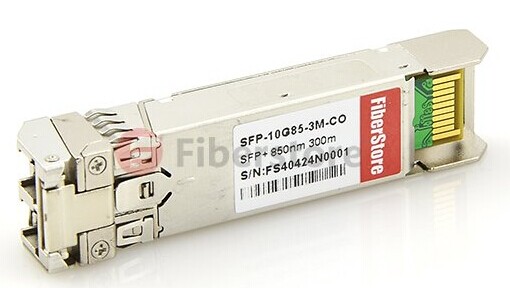10GbE Optical Standards and SFP+ Transceivers
From the origin of 10G Ethernet, optical transceivers have been developed along the way to meet the increasing demand for higher-performance servers, storage and interconnects. SFP+ transceiver is an enhanced version of SFP that supports data rates up to 10 Gbit/s. 10G SFP+ transceiver is a popular industry format supported by many network component vendors. In comparison to earlier XENPAK or XFP module, SFP+ transceiver is more compact and leaves more circuitry to be implemented on the host board instead of inside the module. This article will introduce the 10GbE optical standards and the most common types of 10G SFP+ transceivers.
SR stands for short reach. 10GBASE-SR is a port type for multi-mode fiber and uses 850 nm lasers. It is the original multi-mode optics specification. Up till now, it is still one of the most frequently used because of its cost-effectiveness. However, 10GBASE-SR is highly sensitive to fiber types. The 10GBASE-SR transceiver (such as Cisco SFP-10G-SR) supports a link length of 26m on standard Fiber Distributed Data Interface (FDDI) grade multi-mode fiber (MMF). Using 2000MHz km MMF (OM3), up to 300m link lengths is possible. Using 4700MHz km MMF (OM4), up to 400m link lengths is possible.
LR stands for long reach. 10GBASE-LR is a port type for single-mode fiber and uses 1310 nm lasers. The 10GBASE-LR transceiver can reach up to 10km over single-mode fiber. There is no minimum distance for LR, thus it is also suitable for short-distance connections over single-mode fiber. The SFP-10G-LR-X is a multirate 10GBASE-LR, 10GBASE-LW, and OTU2/OTU2e module for extended operating temperature range. It supports a link length of 10 kilometers on standard single-mode fiber.
10GBASE-LRM (Long Reach Multi-mode) originally specified in IEEE 802.3aq is a kind of specification for multi-mode fibers and uses 1310nm lasers. The SFP-10G-LRM transceiver module supports link lengths of 220m on standard Fiber Distributed Data Interface (FDDI) grade multi-mode fiber (MMF). To ensure that specifications are met over FDDI-grade, OM1 and OM2 fibers, the transmitter should be coupled through a mode conditioning patch cord. No mode conditioning patch cord is required for applications over OM3 or OM4.
ER stands for extended reach. 10GBASE-ER is a port type for single-mode fiber and uses 1550nm lasers. 10GBASE-ER transceiver can reach up to 40km over single-mode fiber. Due to the laser power, attenuation is required for links less than 20km long.
10GBASE-ZR transceiver can reach up to 80km over single-mode fiber. Due to the extremely high transfer energy, significant attenuation is required for shorter links. Use of ZR optics should be preceded with an optical power test of the fiber span in question to ensure a problem-free deployment. Interestingly, 10GBASE-ZR is actually not an IEEE standard, though most vendors provide a ZR option. The SFP-10G-ZR provided by Fiberstore is a multirate 10GBASE-ZR, 10GBASE-ZW and OTU2/OTU2e module. It supports link lengths of up to about 80 kilometers on standard single-mode fiber (SMF, G.652). This interface is not specified as part of the 10 Gigabit Ethernet standard and is instead built according to Cisco specifications.
Fiberstore is a leading supplier of SFP+ transceivers. We have a large selection of SFP+ transceivers in stock, such us SFP+ MM 300m, SFP+ 10km, SFP+ 40km, SFP+ 80km, CWDM SFP+, DWDM SFP+, BiDi SFP+, etc. We also provide SFP+ transceivers compatible with famous brands, like the HP 455883-B21 compatible 10GBASE-SR SFP+ transceiver, Finisar FTLX8571D3BCV compatible 10G SFP+ transceiver as well as many other brands. We offer our customers with high-performance and cost-effective products to fulfill their requirements, contributing this way to the customer's success and satisfaction.

